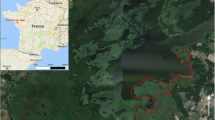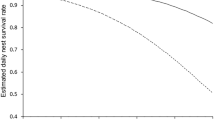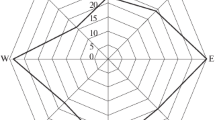Abstract
Baja California represents the northernmost reproductive area for Lepidochelys olivacea. This region is characterized by its high temperature and low humidity. Thus, nest site selection plays an important role in reproductive success. To evaluate the factors affecting site selection for oviposition Las Barracas Beach, located in the south of the peninsula, was visited, from August to November 2000, in weekly periods. A density of 2.55 nests ha−1 was estimated from a total of 55 nests counted. A hatching success of 73.7% was observed, with 23.7% mortality and 2.5% of eggs without apparent development (eggs counted=4,031). On the day of oviposition, the relative surface humidity (between 0.75% and 1.75%) and temperature (32°C) preferred by the females for nest construction was determined at the nest site, as well as the mean distance between the nests and the high tide line for that day (17.65 m). Hatching success was affected by humidity and distance. In addition, hatching success was higher between 10 and 30 m above the high tide line measured on the day of oviposition (surface humidity ca. 1%). A total of 874 hatchlings were measured, with an average of 42.1 mm straight carapace length. Larger sizes were found in October and smaller ones in November. Generally speaking, the sizes found here were larger than those obtained in other areas. This is probably due to two factors: (1) the nests in Las Barracas were kept in situ, whereas in other areas nests are sometimes incubated artificially and (2) the nesting population of southern Baja California is different from the eastern Pacific population.





Similar content being viewed by others
References
Ackerman RA (1997) The nest environment and the embryonic development of sea turtles. In: Lutz PL, Musick JA (eds) The biology of sea turtles. CRC Press, Boca Raton, Fla., pp 83–106
Amador-Medina M, Rodríguez-Guzman CA, Salomón-Montijo B, Verdugo-Valenzuela D, Enciso-Saracho F, Barraza-Osuna MA (2000) Analisis de la anidacion de la tortuga golfina (Lepidochelys olivacea) en Playa Ceuta, Sinaloa, Mexico. In: Abstracts XVII encuentro nac interuniv. para la invest. y conservación de tortugas marinas en México. Universidad Veracruzana, Jalapa,Mexico, p 33
Anaya-Reyna G (1993) Conservación del arrecife coralino de Cabo Pulmo: avances sobre el proceso de planeación y propuesta de lineamientos de manejo. Tesis de licenciatura, UABCS, La Paz, Mexico
Anonymous (1994) Concern rises over threat to Indian turtles. Mar Turtle Newsl 64:1–3
Anonymous (1995) Diario oficial de la federación del 6 de Junio. Secretaría de Pesca, México D.F., Mexico
Boulon RH Jr (1999) Reducing threats to eggs and hatchlings: in situ protection. In: Eckert KL, Bjorndal KA, Abreu-Grobois FA, Donnelly M (eds) Research and management techniques for the conservation of sea turtles. Publication no. 4, IUCN/SCC Marine Turtle Specialist Group, Washington, D.C., pp 169–174
Carretero-Montes RE, Trejo-Robles JA (2000) Hatching and emergence of Lepidochelys olivacea from protected and unprotected nests in “La Gloria” (Playón de Mismaloya), Jalisco, México: 1991–1994. In: Abreu-Grobois FA, Briseño-Dueñas R, Márquez R, Sarti L (eds) Proceedings of the 8th international sea turtle symposium. NOAA Tech Memo NMFS 436:1–184
Casas-Andreu G (1978) Análisis de la anidación de tortugas marinas del género Lepidochelys en México. An Cent Cienc Mar Limnol 5:141–158
Castellanos R, Jacobo J, Preciado A, Enciso I (2000) Disminución de la anidación de tortugas marinas (Lepidochelys olivacea) en Villa del Mar, Cabo Corrientes, Jalisco, México (1996–1999). In: Abstracts XVII encuentro nac. interuniv. para la invest. y conservación de tortugas marinas en México. Universidad Veracruzana, Jalapa, Mexico, p 2
Dominguez-Bello I, Rincón-Pérez M, Girón-Montes C, De la Cruz-Ochoa (2000) Protección y conservación de la tortuga marina en la reserva de la biósfera La Encrucijada, Chiapas, México. In: Abstracts XVII encuentro nac. interuniv. para la invest. y conservación de tortugas marinas en México. Universidad Veracruzana, Jalapa, Mexico, p 7
Ehrenfeld DW (1979) Behavior associated with nesting. In: Harless M, Morlock H (eds) Turtles: perspectives and research. Wiley, New York, pp 417–434
Foley AM (2000) The effect of incubation environment on loggerhead hatchlings and a potential advantage of temperature dependent sex determination. In: Kalb HJ, Wibbels T (eds) Proceedings of the 19th international sea turtle symposium. NOAA Tech Memo NMFS 443:1–16
Fritts TH, Stinson ML, Márquez R (1982) Status of sea turtle nesting in southern Baja California, México. Bull South Calif Acad Sci 81:51–60
Gonzalez-Padilla AG (2000) Programa nacional de protección de las tortugas marinas en el Parque Nacional Lagunas de Chacahua, Oaxaca, temporada 1999–2000. In: Abstracts XVII encuentro nac. interuniv. para la invest. y conservación de tortugas marinas en México. Universidad, Veracruzana, Jalapa, Mexico, p 42
Hendrickson JR (1996) Nesting behavior of sea turtles with emphasis on physical and behavioral determinants of nesting success or failure. In: Kezdi A (ed) Handbook of soil mechanics, soil testing, vol II. Elsevier, Amsterdam, pp 53–57
Hernández-Dávila J, Escoppinichi R, León-Brust RA (1991) Manual operativo del laboratorio de suelo y agua. UABCS, La Paz, Mexico
Hirth HF (1980) Some aspects of the nesting behavior and reproductive biology of sea turtles. Am Zool 20:507–523
Horrocks JA, Scott NM (1991) Nest site location and nest success in the hawksbill turtle (Eretmochelys imbricata) in Barbados, West Indies. Mar Ecol Prog Ser 69:1–8
INEGI (Instituto Nacional de Geografía e Informática) (2000) Anuario estadístico del estado de Baja California Sur. INEGI, Mexico
Lutcavage ME, Plotkin P, Witherington B, Lutz PL (1997) Human impacts on sea turtle survival. In: Lutz PL, Musick JA (eds) The biology of sea turtles. CRC Press, Boca Raton, Fla., pp 387–409
Márquez R (1990) FAO species catalogue, vol 11. Sea turtles of the world. An annotated and illustrated catalogue of sea turtle species known to date. FAO Fish Synop 111–81
Márquez R (1996) Las tortugas marinas y nuestro tiempo. Fondo de Cultura Económica, México D.F., Mexico
Márquez R, Villanueva AO, Peñaflores C (1976) Sinópsis de datos biológicos de la tortuga golfina. INP Sinop Pesca, México D.F., Mexico
Miller JD (1997) Reproduction in sea turtles. In: Lutz PL, Musick JA (eds) The biology of sea turtles. CRC Press, Boca Raton, Fla., pp 51–81
Mortimer JA (1990) The influence of beach sand characteristics on the nesting behavior and clutch survival of green turtles (Chelonia mydas). Copeia 3:802–817
Narro-Farías E (1994) Física de suelos con enfoque agrícola. Trillas, México D.F., Mexico
Nichols WJ, Seminoff JA (1994) Sea turtles in the Gulf of California: where have they gone? Not Cent Estud Desiertos Ocean 1:8–10
Nichols WJ, Resendiz A, Seminoff JA, Resendiz B (2002) Research on East Pacific green turtles on Baja California feeding grounds: a general life history model. In: Mosier A, Foley A, Brost B (eds) Proceedings of the 20th annual symposium on sea turtle biology and conservation. NOAA Tech Memo NMFS 477
Packard GC, Packard MJ (1994) The physiological ecology of reptilian eggs and embryos. In: Gans C, Huey RB (eds) Biology of the Reptilia, vol 16. Ecology B: defense and life history. Branta Books, Michigan, USA, pp 523–605
Plotkin PT, Rostal DC, Byles RA, Owens DW (1997) Reproductive and developmental synchrony in female Lepidochelys olivacea. J Herpetol 31:17–22
Renán-Galindo X (1995) Análisis de la población de hembras desovantes de Lepidochelys olivacea y su potencial reproductivo durante la temporada de anidación de 1995 en el campamento “El Verde” en Mazatlán, Sinaloa. Reporte de Servicio Social, UAM, Xochimilco
Roosenburg WM (1996) Maternal condition and nest site choice: an alternative for the maintenance of environmental sex determination? Ibis 36:157–168
Salame-Méndez A (1998) Influencia de la temperatura de incubación en la determinación del sexo en quelonios. Rev Soc Mex Hist Nat 48:125–136
Spotila JR, O’Connor MP, Paladino FV (1997) Thermal biology In: Lutz PL, Musick JA (eds) The biology of sea turtles. CRC Press, Boca Raton, Fla., pp 297–314
Trejo-Robles JA, Carretero-Montes RE, Silva-Bátiz FA (2000) Anomalías en embriones de tortuga golfina en nidos in situ y transplantados a corrales protegidos, Reserva Playón de Mismaloya, Jalisco, México. In: Abstracts XVII encuentro nac. interuniv. para la invest. y conservación de tortugas marinas en México. Universidad Veracruzana, Jalapa, Mexico, p 25
Turner I (1993) The total water content of sandy beaches. J Coast Res 15:11–26
Wood DW, Bjorndal KA (2000) Relation of temperature, moisture, salinity, and slope to nest site selection in loggerhead sea turtles. Copeia 1:119–128
Zar JH (1999) Biostatistical analysis. Prentice Hall, New York
Acknowledgements
We would like to thank A. Salame Méndez, R.B. Dueñas, and J.U. Ramírez for their observations to the manuscript and P.W. Sammarco and an anonymous referee for comments that substantially improved the presentation of this paper. The first author expresses gratitude to A. López Gasca and M. López Castro for their everlasting support during the realization of this work and to the personnel of Parque Marino Nacional de Cabo Pulmo for the facilities made available for this project.
Author information
Authors and Affiliations
Corresponding author
Additional information
Communicated by P.W. Sammarco, Chauvin
Rights and permissions
About this article
Cite this article
López-Castro, M.C., Carmona, R. & Nichols, W.J. Nesting characteristics of the olive ridley turtle (Lepidochelys olivacea) in Cabo Pulmo, southern Baja California. Marine Biology 145, 811–820 (2004). https://doi.org/10.1007/s00227-004-1359-x
Received:
Accepted:
Published:
Issue Date:
DOI: https://doi.org/10.1007/s00227-004-1359-x




